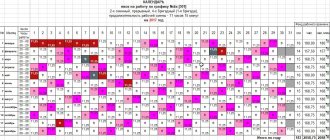What should be the time between shifts?
Article 107 of the Labor Code of the Russian Federation defines the main types of rest time for workers, among which there is daily (between shifts) rest.
There is no provision in federal law on the procedure for its provision and duration. However, at the end of the work shift, the employee has the right to receive inter-shift rest. The employer must relieve the employee from performing work duties and give him the right to manage his free time at his own discretion. When working in shifts, the employee’s right to daily (between shifts) rest arises after he has worked the established hours. With normal working hours, the norm is no more than 8 hours a day and 40 hours a week (Article 91 of the Labor Code of the Russian Federation). It can vary both less and more. An employee may be involved in work beyond the norm, for example, on an internal part-time basis. In this case, the work shift should not last more than 12 hours. With an irregular schedule, the employee’s working day should not exceed 12 hours.
Thus, no matter the schedule, after 12 hours of working time, employees have the right to daily rest between shifts. The employer must accordingly provide it. In case of refusal, the employee exercises his rights through his own actions.
The concept of summarized recording of working time according to the Labor Code of the Russian Federation
Thus, no matter the schedule, after 12 hours of working time, employees have the right to daily rest between shifts. The employer must accordingly provide it. In case of refusal, the employee exercises his rights through his own actions.
But even in this case, the employee is guaranteed a minimum daily (between shifts) break equal to the time worked.
https://youtu.be/iUZ7y19t76o
The legal significance is the moment when this right arises for the employee and the corresponding obligation for the employer.
The rules, for example, may determine that summary accounting is introduced by order (instruction) of the employer (head of the organization, individual entrepreneur), taking into account the opinion of the elected body of the primary trade union organization or without it. 4.
The accounting period for the summary recording of working time is the period within which the average daily and (or) weekly working hours established for a given category of employees must be observed.
Namely, what should be the rest time between shifts: when the employee has the right to rest between shifts, its duration.
If the driver has been driving almost continuously for 8 hours, then he will be able to return to his shift no earlier than 16 hours after the end of his work shift.
Council of People's Commissars of the USSR dated September 24, 1929: the duration of rest between shifts cannot be less than double the length of time worked by the employee the day before. It also includes time spent eating lunch.
Employees are recruited to work at night in compliance with the restrictions established by this Code.
Such an agreement can only be canceled at the request of its parties. Therefore, such agreements take place despite legal prohibitions.
Thus, Article 103 enshrines the right to introduce RMS only at enterprises with a shift work schedule. If it is not, entering summarized working time recording is optional and will not be regulated by law. What it is? RMS is a special regime of rest and work time, which is based on the principle of changing work schedules and “sliding” vacation days. The law mentions some points regarding this type of breaks. Rest between shifts is the time allotted to an employee for his own activities after one workday and before the next. Its duration is not regulated by law.
If the manager is at fault, payment for the accounting period is paid to the employee in full. And if the fault lies on the shoulders of the employee, several cases are possible: payment of average earnings if the employee was absent due to poor health and cancellation of payment in case of systematic unexcused absences. Inter-shift rest.
When establishing a summarized accounting of working hours, it is mandatory to observe the duration of the employee’s rest between the end of work and its start on the next working day (work shift).
However, an employee may be involved in work beyond normal working hours, for example, on an internal part-time basis or overtime work. In such a situation, the employee’s working day cannot exceed 12 hours.
The Labor Code of the Russian Federation notes a minimum gap that may be established for employees of some organizations. Among them are drivers and medical personnel. Articles of the Labor Code of the Russian Federation The Labor Code of the Russian Federation contains Article 107.
With weekly and cumulative recording of working time, an employee in the accounting period may be involved in work beyond the working hours established in the organization. The same applies to workers with irregular working hours. However, even in this case, the employee’s working day should not last more than 12 hours.
The Labor Code of the Russian Federation notes a minimum gap that may be established for employees of some organizations. Among them are drivers and medical personnel. Articles of the Labor Code of the Russian Federation The Labor Code of the Russian Federation contains Article 107.
Even the lack of adequate sleep of less than 8 hours a day entails the risk of developing a number of psychological and physical diseases, given that the body does not fully recover and, as work continues, requires more and more energy expenditure, which is no longer available.
This means that its processing time is 4 hours. According to this, management must calculate 2 hours of overtime at a rate of 1.5 - another 2 hours at a double rate.
Any full-time employment involves the provision of rest, which will allow not only to restore health, but also to recharge with vigor and efficiency. And since the length of workers’ shifts varies, as does the actual intensity of work, the law provides for a certain minimum time, which is intended to restore strength and performance between shifts.
The Labor Code of the Russian Federation does not require that the summarized recording of working time be introduced directly by the internal labor regulations. The internal labor regulations should only establish the procedure for introducing summarized accounting.
Inter-shift rest as a type of time provided to the employee at his own discretion is stipulated in Art. 107 Labor Code of the Russian Federation.
Length of rest between shifts
The duration of daily (between shifts) rest is not defined in federal law. However, with a shift schedule, the break cannot be less than double the working time in the shift preceding the rest. So, with the normal duration of a work shift being 8 hours and using daily working hours, the employee must rest at least 16 hours. This balance is disrupted when an employee is involved in work beyond the norm. But even in this case, the employee is guaranteed a minimum daily (between shifts) break equal to the time worked.
Similar rules apply when involving an employee on daily duty. His working day in this case lasts 24 hours. At the end of duty, the employee has the right to a full rest between shifts equal to 48 hours. In exceptional cases, by agreement with the employee, the break can be reduced to 24 hours, that is, to the duration of the shift he worked.
Thus, the minimum daily (between shifts) rest established by law is the amount of hours worked by the employee the day before during the work shift or day. The Labor Code of the Russian Federation does not allow a shorter duration, so this standard should be strictly observed. Although, within the framework of an exception, the employer and employee can enter into an agreement on the performance of work duties during the period of rest with the obligatory provision of additional benefits and benefits to the latter. Such an agreement can only be canceled at the request of its parties. Therefore, such agreements take place despite legal prohibitions.
When and why to install
Employers who have established a shift schedule for their specialists may unknowingly violate the provisions of labor legislation.
The bottom line is that the time actually worked by an employee may exceed the norms established by law. If this happens, you will need to arrange overtime hours for the employee, which is a rather complicated process.
Article 99 of the Labor Code of the Russian Federation provides a list of situations when a company can use overtime work. It mainly includes emergency situations related to accidents, natural disasters and safety precautions. It would be an offense for employees to work overtime under other circumstances.
Also, when using overtime, the worker’s written consent and accurate recording of overtime hours are required.
In addition, this time must comply with established limits: no more than 4 hours over 2 working days and no more than 120 days per year.
In accordance with Article 104 of the Labor Code of the Russian Federation, summarized accounting is applied for the established accounting period. It is regulatory for the entire organization and will be used for each specialist transferred to it.
Rest time between shifts: important to know
In a number of industries, the duration of rest between two shifts cannot be less than 12 hours. Such daily (between shifts) rest is provided for drivers of trolleybuses and trams, and for water transport workers. Moreover, the time of daily (between shifts) rest for the latter is considered to be the intervals between shifts or periods of shipboard work.
The floating crew of fishing vessels are provided with rest between shifts of 12, 16, 17 or 18 hours a day, depending on the duration of the shift (watch).
When working on a rotational basis, the duration of daily (between shifts) rest, taking into account lunch breaks, can be reduced to 12 hours. Unused hours of rest between shifts are summed up together with hours of weekly rest and provided as additional days off in the accounting period.
The duration of inter-shift rest for dispatchers and other air traffic control service employees cannot be less than double the duration of work on the working day (shift) preceding the rest. In some cases, rest time may be reduced to the duration of the previous shift, with a corresponding increase in the current reporting month.
The break between shifts must be at least
1. The types of rest time provided for in Article 107 of the Labor Code of the Russian Federation differ depending on the time and purpose of its provision.
2. Breaks during the working day (shift) are provided for rest and food (see commentary to Article 108) or for heating and rest (see commentary to Article 109).
3. Daily (between shifts) rest is the time from the end of work until it starts the next day (shift). Its duration is determined by the internal labor regulations or the shift schedule and depends on the duration of daily work and the lunch break.
The Labor Code does not establish a minimum duration of daily (between shifts) rest.
According to established practice, the work schedule in an organization is established, as a rule, in such a way that the minimum duration of daily (between shifts) rest, together with the lunch break, is no less than double the duration of work on the day (shift) preceding the rest.
For certain categories of workers in some industries, the minimum duration of daily (between shifts) rest is regulated in special regulatory legal acts that establish the specifics of working hours and rest time.
By order of the State Fisheries Committee of Russia dated August 8, 2003.
N 271, the floating crew is provided with daily rest of 12, 16, 17 or 18 hours a day, depending on the established duration of the shift (watch).
The specific duration of daily (between shifts) rest is provided for in the relevant regulatory legal acts for workers whose work is directly related to the movement of vehicles. For example, according to paragraph.
18 Regulations on the peculiarities of working hours and rest time for workers of floating vessels of inland water transport vessels, approved. By Order of the Ministry of Transport of Russia dated May 16, 2003 N 133 (RG. 2003.
In accordance with clause 12 of the Regulations on the specifics of working hours and rest time for workers involved in air traffic control of civil aviation of the Russian Federation, approved. By Order of the Ministry of Transport of Russia dated January 30, 2004 N 10 (BNA RF. 2004.
N 11), the duration of daily (between shifts) rest for an air traffic controller cannot be less than double the duration of work on the working day (shift) preceding the rest.
https://youtu.be/Aic-bJFwZ70
In some cases, the duration of daily (between shifts) rest may be reduced to the duration of the previous work shift with a corresponding increase in rest time during the current monthly period.
According to clause 25 of the Regulations on the peculiarities of working hours and rest periods for car drivers, approved.
By Order of the Ministry of Transport of Russia dated August 20, 2004 N 15 (BNA RF. 2004.
N 45), the duration of daily (between shifts) rest, together with the break time for rest and food, must be at least twice the duration of work on the working day (shift) preceding the rest.
When recording working hours in total, the duration of daily (between shifts) rest must be at least 12 hours.
For intercity transportation, with cumulative accounting of working hours, the duration of daily (between shifts) rest at turnover points or at intermediate points cannot be less than the duration of the previous shift, and if the vehicle crew consists of two drivers - at least half the time of this shift with a corresponding increase in rest time immediately after returning to your place of permanent work.
5. Non-working holidays are days free from work established by the Labor Code, dedicated to outstanding events or memorable traditional dates (see commentary to Article 112).
Vacation as a type of rest time is a certain number of calendar days free from work (in addition to holidays, non-working days) provided to employees for continuous rest and restoration of working capacity while maintaining their place of work (position). There is a distinction between annual paid leave (see commentary to Article 114) and leave without pay (see commentary to Article 128).
It is provided in the next working week and is in total equal to the reduction in breaks.
- The driver's rest between shifts can be divided into 2 or 3 parts. In this case, the duration of rest increases to 12 hours, and the minimum duration of one of the parts is 8 hours.
The lack of a suitable parking space during rest periods between shifts is a common situation in intercity transportation. The driver must follow to a suitable parking spot. When drawing up a work schedule at an enterprise, it is necessary to take into account legal requirements and provide employees with the opportunity for proper rest.
Attention
Meal breaks are also included in the rest periods between shifts. For example, if a driver spent eight hours on the road, then he has every right to rest for sixteen hours. However, if the driver does not have a permanent job, then the employer can use the method of adding up the time worked.
In this case, the duration of rest between work shifts should not be less than twelve hours.
One of the types of rest guaranteed by the state to workers is between-shift rest.
Is there a certain duration of such a break established by law? Is there a dependence of the duration of breaks between shifts on the profession or type of work performed? In the article we will look at the length of daily rest between shifts for drivers and health workers and what responsibility is for non-compliance with the standards.
What it is? Inter-shift rest should be understood as the break time between the end of one work shift (day) and the beginning of another. The duration of such breaks is not regulated by the Labor Code. This is regulated by local regulations developed at the enterprise. For example, shift schedules or internal labor regulations.
The intershift break (the minimum duration of daily rest between shifts) must be (together with the lunch break) no less than twice the length of the work time in the shift preceding the rest. This is established so that when workers move from one shift to another, there is no violation of the workers’ right to rest.
https://youtu.be/tQjN48tFB-w
This rule is applied in practice to shift work in discontinuous and continuous production. Such a broad understanding of rest time actually includes not only periods during which the employee actually takes a break from work and uses it as he chooses (playing sports, reading, going to the theater, tending the garden, etc.), but also the time which he spends on movement (travel) to his place of work and from work home.
Only as an exception, for certain categories of workers under certain conditions, regulatory legal acts provide for the inclusion of travel time to work and home in working hours according to the relevant standards.
Inter-shift rest: Labor Code of the Russian Federation
The Labor Code of the Russian Federation does not establish the exact rest time between shifts. Standards for its duration can be found in the following regulations:
- Resolution of the Council of People's Commissars of the USSR dated 09/24/1929 “On working time and rest time in enterprises and institutions switching to a continuous production week”, this is the main document that should have guided employers, but in 2020 it was canceled (Government Decree No. 1205 dated 04.10 .2017). In this document, the duration of daily rest was set at least twice the length of the shift, taking into account the lunch break.
- SanPin SP 2.2.2.1327-03 dated May 26, 2003. Establishes the minimum duration of daily rest between shifts in normal mode and in emergency situations. Here the standards are the same as in the previous document, with the only difference being that lunch is no longer included in the duration of work.
- Legislative and regulatory acts for specific industries (for example, for drivers of ground and air vehicles).
Note! When taking into account the duration of rest between shifts, one must not forget about Article 110 of the Labor Code of the Russian Federation, which states that each employee must have a continuous rest period of at least 42 hours every week. In practice, this means that a work schedule “week after week” or “15 days after 15 days” will violate the provisions of this provision of the law.
Weekly uninterrupted rest
Weekly uninterrupted rest must be at least 42 hours. However, this type of rest does not include inter-shift rest.
Thus, with a standard 5-day working week, the duration of rest on a day off should be no less than 42 15 = 57 hours.
https://www.youtube.com/watch?v=ytcopyrightru
With the summarized working time recording mode, days off are assigned on different days. In this case, the number of days off must be no less than the number of full weeks of the month. Those. There must be at least one day off in each week.
Inter-shift rest with summarized recording of working hours
Inter-shift rest as a type of time provided to the employee at his own discretion is stipulated in Art. 107 Labor Code of the Russian Federation.
The labor legislation does not contain norms establishing the duration and rules for providing between-shift rest specifically in the case of cumulative accounting of working hours, and in other modes as well.
However, to this day, clause 11 of the resolution of the Council of People's Commissars of the USSR “On Working Time...” dated September 24, 1929 is in force, according to which after the shift there must be a break, the duration of which must exceed the duration of the worked shift at least 2 times.
This rule applies to all modes in which there are shifts.
According to Part 1 of Art. 104 of the Labor Code of the Russian Federation, summarized recording of working hours (SURV) is introduced when the employer cannot comply with the requirements for daily/weekly work hours. Special cases of RMS are:
- flexible schedule;
- shift work.
Thus, the rest time between shifts during RSA does not depend on what regime is established at the enterprise as a whole or for a specific employee. It is established taking into account the requirements of Chapter. 18 Labor Code of the Russian Federation.
For some professions, there are requirements for the length of rest time during RSA, regardless of the mode. For example, according to clause 25 of Order No. 15 of the Ministry of Transport of Russia dated August 20, 2004, organizations conducting RMS must provide drivers with at least 12 hours of rest.
Responsibility for failure to comply with the duration of rest between shifts
In case of violation of the rest regime between workers' shifts, the punishment for the employer will be determined according to the articles of the Code of Administrative Offenses of the Russian Federation:
- Article 5.27 does not separately highlight this violation, therefore the measure of liability is established in accordance with paragraphs 1 or 2.
- Clause 2 of Article 11.23 provides for punishment directly for persons driving vehicles (drivers) if they violate the rest regime.
Punishment under Art. 5.27 is expressed in the imposition of a fine from 1,000 to 50,000 rubles, depending on the object of punishment (official, individual entrepreneur, enterprise). Art. 11.23 provides for a fine for the driver from 1000 to 3000 rubles.
According to general rules, the break between shifts should be no less than the duration of the work shift multiplied by two. For certain categories of workers it may vary depending on working conditions.
Rest time between shifts according to the Labor Code of the Russian Federation during a shift work schedule: how the schedule is drawn up
The work schedule and rest time between shifts during shift work is established taking into account the provisions of Art. 91, 94, 103, 108, 110 Labor Code of the Russian Federation:
- The shift schedule is drawn up in such a way that labor hour standards are observed depending on the selected accounting period: month, quarter, year.
- The standard working time for a month is calculated according to the formula, approved. by order of the Ministry of Health and Social Development of the Russian Federation dated August 13, 2009 No. 588n:
N = (Rn / 5) × Rd – Chppd,
where: Rn - length of the working week;
Rd — number of working hours per month;
Chppd - number of reduced hours on pre-holiday days.
For example, the monthly rate for March 2020 is: (40 / 5) × 22 – 1 = 175 hours. The holiday of March 8th fell on Wednesday, this day is a non-working day, and the pre-holiday day of March 7th is shortened by 1 hour.
The same order specifies the procedure for calculating the norm for the year.
- It is impossible to assign an employee to 2 shifts in a row.
- The schedule takes into account the break time provided for rest and meals. Whether it is considered work depends on whether the employee has the opportunity to leave the workplace and use the time as he or she wishes.
- Once a week, the employee must have a break of at least 42 hours.
- The shift schedule is drawn up no later than a month before its introduction.
- The established schedule is communicated to each employee (in practice, against signature).
If an employee goes to work during rest during a shift work schedule, this day must be paid no less than double the amount in accordance with Art. 153 Labor Code of the Russian Federation.
Payroll preparation
The employer must establish the procedure for calculating wages for cumulative accounting. It can be set either as an hourly rate or as a salary. The procedure for setting the hourly rate is also determined by the employer. It is calculated based on the standard working time for the accounting period and can be calculated based on the monthly standard of working time or based on the standard working time for the year.










